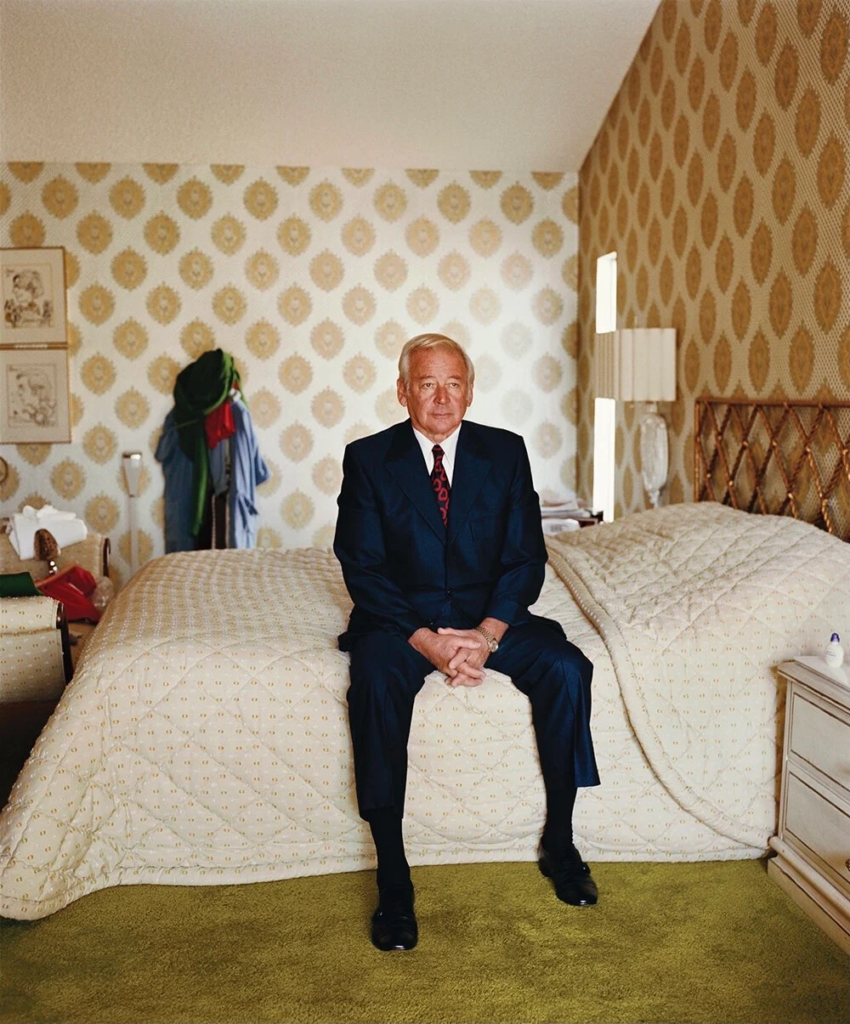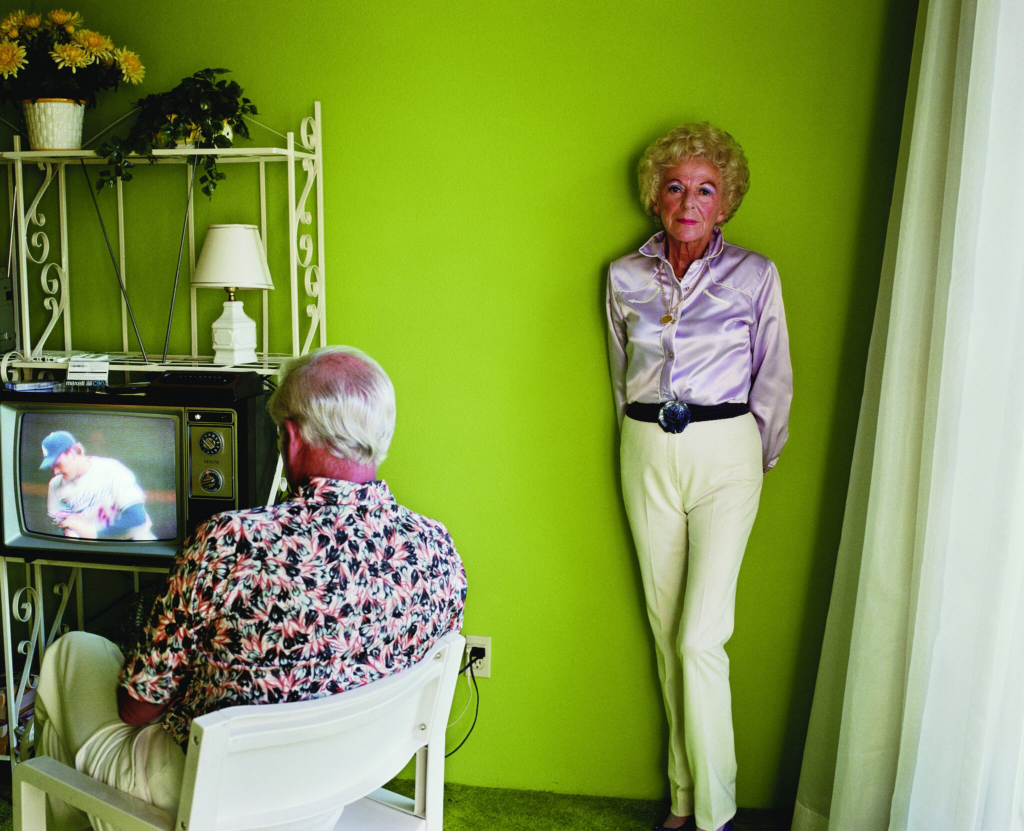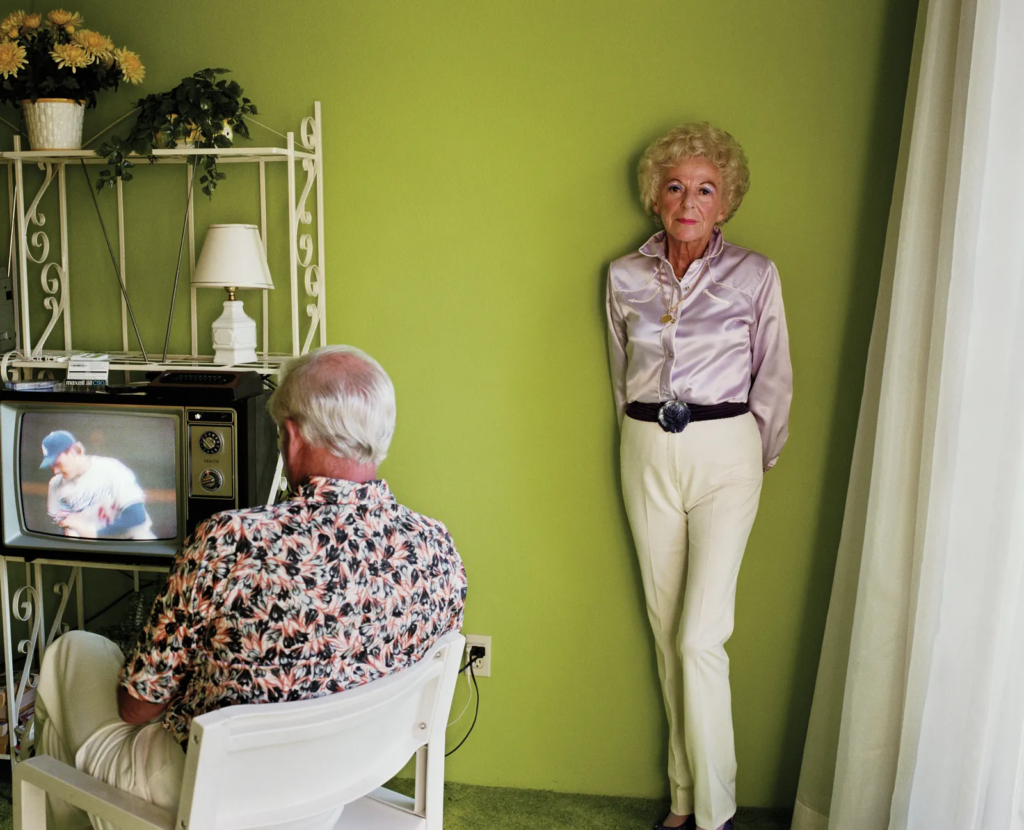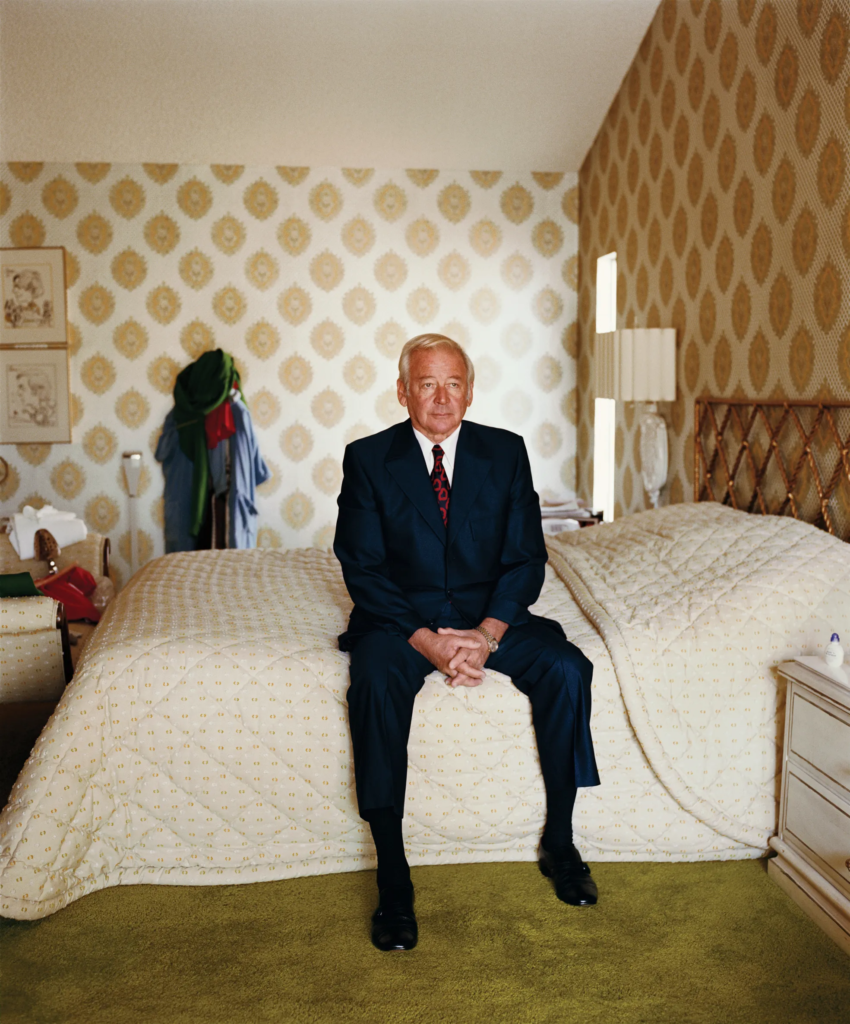Larry Sultan
Larry Sultan was born 13th July 1946 in Brooklyn New York to a Jewish family. He grew up in the San Fernando Valley, part of Los Angeles, California, where his parents moved when he was an infant. He graduated from the University of California, Santa Barbara with a bachelor’s degree in political science, and received a master’s degree in fine arts from the San Francisco Art Institute in San Francisco.
He was an American photographer and started his career in the 1970’s. In 1977, he published a collection of photographs he found in corporate and government archives called ‘Evidence’ with a photographer called Mike Mandel, which the New York Times characterised as “a watershed in the history of art photography.” The two men also created billboards aimed at slowing down road traffic. He then published ‘Pictures from Home’ from 1982-1992, followed by his 2004 assignment for Maxim, which consisted of photographs of middle-class residences rented by the porn industry in the San Fernando Valley, which led to another photographic series called ‘The Valley.’ He also photographed Paris Hilton for Interview in his parents’ bedroom in his childhood home.
Sultan was an instructor of photography at his alma mater, the San Francisco Art Institute, from 1978 to 1988. He then taught at the California College of the Arts in San Francisco as Chair of the Photography Department from 1993 to 1999, and as distinguished professor of art from 1989 to 2009.
He served on the board of trustees of the Headlands Centre for the Arts from 1992 to 1998. At the time of his death, 13th December 2009, he was the artist trustee at San Francisco Museum of Modern Art, a position he had taken up in the same year. He died of cancer and died at his home in Greenbrae, California, with his wife Katherine Sultan, also known as Kelly Sultan.

Pictures From Home

Pictures from Home was first published in 1992 and was a collection of photographs taken of his parents in the San Fernando Valley from 1982 to 1992, whose role was to question societal expectations of gender and aging. Sultan returned home to Southern California, which is where he grew up in his childhood home in the 1980’s and began his work. His home became a source of inspiration for a number of his projects. In ‘Pictures from Home’ he combines contemporary photographs with film stills from home movies, fragments of conversation, Sultan’s own writings and other memorabilia. This results in a narrative that collages both documentary and staged images causing the boundary between them to thin and create images of the psychological as well as physical landscape of suburban family life. Simultaneously, the distance usually maintained between the photographer and his subjects also slips in an exchange of dialogue and emotion that is unique to this work.
“What drives me to continue this work is difficult to name. It has more to do with love than with sociology. With being a subject in the drama rather than a witness. And in the odd and jumbled process of working, everything shifts: the boundaries blur, my distance slips, the arrogance and illusion of immunity falters. I wake up in the middle of the night, stunned and anguished. These are my parents. From that simple fact, everything follows.” – Larry Sultan
His photobook displays the flow of ordinary life and Sultan noted that he wanted the images in Pictures from Home to “become part of a larger narrative…to slam up against other images (an afterimage). I want to measure how a life was lived against how a life was dreamed.”
Article on His Work
Review in the Guardian Newspaper-
‘Pictures from home by Larry Sultan review- When mom and dad lived in the dream‘
‘Sultan’s 80s portraits of his parents are both artful and authentic‘

Larry’s work published in 1992 ‘Pictures from home’ is an intriguing visual memoir that also explores all American families, both as reality and a construct. Sultan began the project when Ronald Reagan was president and “the institution of the family was being used as an inspirational symbol by resurgent conservatives. I wanted to puncture this mythology of the family and to show what happens when we are driven by images of success. And I was willing to use my family to prove a point.”
Although this was the original motive, his book is much too personal and self-questioning to be anything other than a tortured labour of love, as it allowed him to see his parents and himself in a new way. Sultan used family snapshots and stills from home movies alongside his own photographs of his parents, who were retired in a desert community near Palm Springs. Their expansive house and gardens are the setting for Sultan’s portraits, which, whether intimate or cinematic, are always artfully choreographed, as if reminding us that we are looking at a highly constructed narrative.
Pictures from Home also included the merging of images and text, including painful reflections of Sultan’s upbringing, his parents, his photography, and the wisdom of this project, which are undercut with his father’s more macho, matter-of-fact monologues. The tension between the two is the classic generational tension between father and son; the one seeking affirmation of his work, the other baffled by it. “Every few months I visit, loaded down with camera gear and ideas for pictures,” writes Sultan. “It takes a day or two for most of these ideas to seem strained or foolish and then I’m left with cases of unexposed film and a feeling of desperation.”
Pictures from home also displays the particular tensions of photography: the tricky balancing act between critical distance and emotional engagement, between empathy and voyeurism.
Sultan describes sneaking into his mother’s bedroom and photographing her as she lay sleeping – “I was so apprehensive of waking her that I breathed in rhythm with her.” He photographs the underside of her foot, which he realises he has never seen before. In his furtive excitement, he wishes he could “photograph it again and again.” It is a strange, heightened interlude, made more so by the realisation that she was not really asleep – “We were co-conspirators. Just as I was secretly photographing, she was secretly awake. She felt me looking.”
Ultimately, as Sultan acknowledged, Pictures from Home is an impossible project. “I realise that beyond the rolls of film and the few good pictures,” he writes, “the demands of my project and my confusion about its meaning, is the wish to take photography literally. To stop time. I want my parents to live for ever.” In a way, he succeeded.
Interview on His Work
‘In 1983 the republicans had hijacked the family and they turned it into a ideological tool and the family values that they were talking about I found them quite oppressive and I felt that family is one of the most complicated, unnerving institutions and it’s the last institution that I think anyone believes in, most of us believe in
Larry sultan found that in 1983 the Republicans has hijacked the family and turned it into an ideological tool. He found that the family values that they were talking about were quite oppressive and he felt that family is one of the most complicated, unnerving institutions and it’s the last institution that anyone believes in, as most people didn’t believe in the government, churches, or in the bank, but family still has a pull on people.
Sultan’s family life was complicated, as his father was a very strong character. He was an orphan that came up out of the lower class and worked his way up to being a vice president at Real Horatia Alger Story. His father did not like that sultan was an artist and gave him a hard time about it, calling him a ‘loser.’ His father lost his job in his early fifties, because the company was sold and he never worked again.
Sultan states, ‘the wound is deeply in the family.’ This led to him beginning to study these at home movies, looking for himself and the evidence of his life. This made him realise that he could reshape them, ‘like a good dream,’ as he could reinsert himself into family life. Looking at the documents of his families at home movies he found they also have a sense that a families projected its dreams onto film emotion, as they celebrate the family in the most mystical, remarkable ways.
This led to him beginning to use the movie stills, their pictures, snapshots and he began to take his own photographs. His photographs were a blend of staged and documentary work, as he was trying to collapse those differences.
Sultan states that, ‘the truth is about performance, how we perform, how we project and the truth can be staged and it can be found. I don’t think there is such a division between the two.’
The images were intimate images, private images, which he then made public. He felt that there was a kind of betrayal that happens when this is done, as something is torn when you go from private to public. A trust. Sultan felt terrible about this throughout the project, as he felt like he had a secret and that he was betraying his parents. To get around this issue he had his parents in a sense be collaborators, as they wrote, discussed the pictures and they dismantled his position. He was under question just as much as the home movies were. The home movies were all fictive and partially true.
This project allowed Sultan to solve a lot of personal issues with his family. His parents came to one of his art openings at MCA in San Diego and there were people asking for his fathers autograph, where his father said, ‘I don’t know whether i’m making you famous, or your making me famous.’ This caused Sultan and his father to be bound together in a very odd enterprise.
His Work






Analysis of 2 Photographs

The type of lighting used in this image is natural lighting, which is coming in through the window on the right, where the curtains are. This image is a staged image, so has high levels of control, because he could manipulate the setting, distance and position of the subjects (his parents) and himself with the camera.
There are neutral colours throughout this image, including the cream/ white trousers, furniture, curtains etc. as well as having that contrast with including more vibrant colours, such as the bright green walls, the yellow flowers and the slightly pink shirt the women is wearing and the patterned black and orange shirt the man is wearing. This image includes lots of lighter tones, due to the neutral colours, but also includes a few darker tones including the belt on the women, the shirt on the man and the tv. There is a bit of texture in this image, due to the objects used in the photograph (the furniture) and the outfits that are being worn (the silk shirt). The way they are positioned creates space and dimension in this image, as the women in stood in the background, while the man is in the foreground. The main viewpoint of this image however, is the women, even though she is in the background.
This image was taken in the photographers childhood home and the subjects are his parents. This image is a staged image and it is trying to present the everyday flow of an ordinary life, while also questioning societal expectations of gender and ageing. This image presents an ordinary flow of life, as the activity presented in this image is watching TV, which is an ordinary activity that almost everyone does. However, this image also presents gender roles, as in the image the male is able to sit down and relax and watch TV, while the female is stood by his side waiting by the looks of it. This may present that the male is more important than the women, which is why he is sat and that the women is waiting to serve him.

The type of lighting used in this image is natural lighting coming in from the windows. There are high levels of control in this image, as it is a staged image, where the position and distance of Sultan’s father and himself with the camera was manipulated.
There are lots of neutral colours in this image, including the warm/ cream bedding and the brown walls. However, there are also some brighter colours including the green carpet and the dark navy suit his father is wearing. There are lots of light tones in this image, which creates a contrast between the darker tones of the subjects suit. There are also a lot of textures in this image, including the textures seen of the carpet, as well as the textures of the bedding. There are also lots of patterns in this image, including the shapes on the bedding and the shapes on the wall paper.
The composition of this image is a simple one, with the subject in the centre of the frame being the main viewpoint.
This photograph was taken in the photographers childhood home and the subject is his father, who he had a very complicated relationship with, because he did not want him to be an artists. However, this photo allowed them to grow closer together and allowed Sultan to discover that his father has more similarities to him than he recognised. His father states, ‘that’s you sitting on the bed, that this is a self-portrait. I know who I am, you know who you are, your values are part of this work, but let’s just make it very explicit. That’s you sitting on the bed.’ This allowed Sultan to recognise that his father was very clear headed and astute about photographic issues.
My Inspiration
I am going to take inspiration from Larry Sultan, because I am also going to take staged images of my parents in the same way he has done in my current home, which I have grown up in, just how he has taken photographs in his childhood home. However, I am not only going to take pictures of my parents, but other family members as well, like my sister for example. I am also going to include archive images, including photographs and films, just how Sultan has, in my photobook, as I am going to also be recreating some of these archives. I am also going to include some of the features he has used in his photobook, like using different paper for certain pages, because I think it works very well and completes the book.
I am also going to experiment with joiners, which I have taken inspiration from David Hockney, but I am also going to create different types of collages, just how Sultan has in his photo book. I may also try and recreate some of Sultan’s photographs, like the one of his father sat on his bed in a suit.
